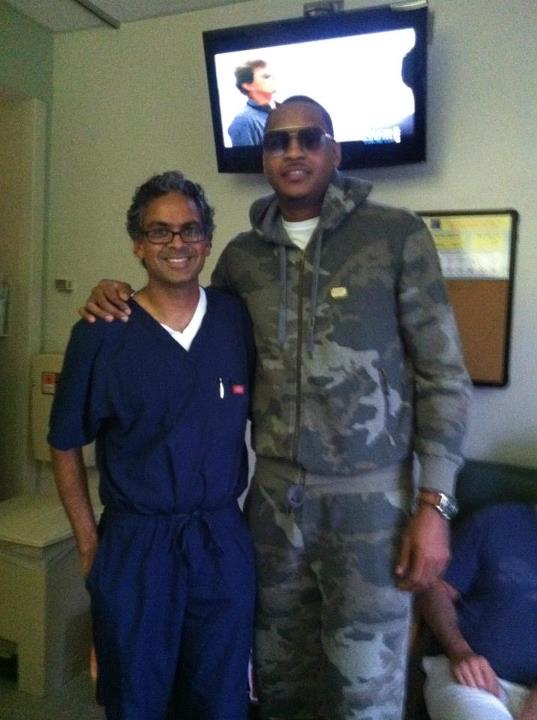At my week 1 recovery update (you can watch the video here), I sat down for this new Loren’s World interview with the man who saved my life, Dr. Aman Patel. I was very lucky to have found one of the top neurological surgeons in the country through our dear friends Carmelo and La La Anthony and want to share what I have learned on my website to raise awareness. I reached out on Twitter for your questions about brain aneurysms and many of them are answered below. I am so grateful to have met Dr. Patel and his family – they are amazing people and he has changed my outlook forever!
Brain Aneurysm: My Interview with Top Neurological Surgeon Dr. Aman Patel
1. What actually is an aneurysm?
An aneurysm is an abnormal widening or ballooning of a portion of an artery due to weakness in the wall of the blood vessel.
2. When we hear that someone has or had an aneurysm it is commonly thought of as a life-threatening event. How is the discovery of an aneurysm different from the common perception that an aneurysm is a life threatening event?
An aneurysm in itself is not life threatening. Aneurysms become life-threatening when the rupture (pop) cause a hemorrhage in the brain (subarachnoid hemorrhage). When an aneurysm ruptures blood exits the artery and enters into the surrounding tissue and spinal fluid space. This rapid exit of blood from the artery can cause the pressure in the brain to become very high which is life threatening. An aneurysm found before it ruptures most often causes no or very mild symptoms. This aneurysm only becomes life-threatening if it ruptures causing a hemorrhage. Fortunately, many aneurysms that are at a higher risk can be treated before they rupture preventing brain hemorrhage. The goal of treating aneurysms that have not ruptured is to prevent future risk of hemorrhage. In many ways, the discovery of such an aneurysm is fortunate because action can be taken before it becomes life threatening.
3. Loren has made public her condition and your treatment of it. She is a very active and strong person and appears to be quite healthy. What can you tell us about the discovery of her condition and the procedure she underwent?
Loren presented with “vague” neurological symptoms consisting of vertigo, left eye blurriness and one episode of facial pain. These symptoms led to a work-up with a MRI and MRA – with the MRA showing an aneurysm arising from the left internal carotid artery just as it entered the brain. The MRA suggested an aneurysm that was 7mm in size. Given the location of the aneurysm it was felt that the visual symptoms were likely due to the aneurysm. It was unclear whether the other symptoms were related to the aneurysm. In addition, given the location and size of the aneurysm and Loren’s young age it was felt that she carried a significant life-time risk of hemorrhage from this aneurysm. Given these facts further study on the aneurysm was performed with a cerebral angiogram to determine the best treatment for this aneurysm. A cerebral angiogram is a procedure in which we pass a catheter through the femoral artery into to vessels that supply the brain. Contrast dye is injected and an x-ray movie is made of the blood vessels. The study is accurate because it images only the blood vessels and allows us to accurately determine the size, location and configuration of the aneurysm and its relationship to the normal vessels. This information is used to determine the best treatment modality. We found that Loren’s aneurysm was 8.5mm in size and had a 4.5mm neck and was located on the left internal carotid artery just as it entered the brain. Using this information we felt that treating the aneurysm with stent-assisted coil embolization was the most appropriate method of treatment. In this procedure a stent is placed across the base of the aneurysm. After this, through a microcatheter that is positioned within the aneurysm itself, platinum microcoils (that look like micro slinkies) are threading through this microcatheter and positioned within the aneurysm. Multiple coils are used to completely fill the aneurysm so that blood no longer enters the aneurysm. The stent functions to prevent the coils from falling or entering into the normal vessel and allows for greater packing of the aneurysm reducing the risk of the aneurysm filling or reforming. This entire procedure is done through a catheter that is entered into the femoral artery via a needle puncture. These procedures are performed by using fluoroscopic x-ray guidance in a biplane angiography room. Loren’s aneurysm was completely occluded with the placement of the stent and 6 coils. We tailor the treatment options for patients depending upon the aneurysm and the patient – other treatment options include coil embolization alone, placement of a flow diverter, and open micro-surgery of the aneurysm. We attempt to treat in the least invasive method; however, the goal is occlusion of the aneurysm. Fortunately, we were able to treat Loren without open surgery.
4. Do certain people have a genetic predisposition to getting aneurysms?
Yes, certain families can have a higher disposition of aneurysms. We are unclear of the exact genetic mechanism, but people who have 2 or more first degree relatives that have had aneurysms are at a higher risk of having an aneurysm. There are also some medical conditions such as, polycystic kidney disease, connective tissue disorders and fibromuscular dysplasia that may carry a higher risk of aneurysm formation.
5. What factors could contribute to the formation of an aneurysm?
Other than the genetic factors listed above – cigarette smoking is the single most modifiable factor that can lead to formation and rupture of aneurysms. Illicit drug use, especially cocaine and amphetamines can also lead to an increased risk of formation and rupture. There is an association of alcohol abuse and aneurysm rupture. Finally, uncontrolled hypertension may be associated with increased risk.
6. What are the early signs and symptoms of an aneurysm?
Unfortunately, most aneurysms are completely without symptoms until they rupture. However, depending upon the location of the aneurysm some aneurysms can cause mild symptoms. Depending on the location of the aneurysm these can range from visual blurriness, double vision, and inability to open an eye, headaches, hearing changes, weakness, numbness, dizziness and vertigo.
7. Are aneurysms sometimes mistaken for other medical issues, if so what?
Given the many aneurysms do not have symptoms and the fact that they symptoms are very variable it is not uncommon for an aneurysm to not be diagnosed or symptoms to be related to other causes. Common medial issues include – migraines, primary eye issues, glaucoma, cataracts, multiple sclerosis, and hypertension.
8. Can you live with an aneurysm?
Absolutely. Many aneurysms incidentally found are very small and carry a tiny risk of hemorrhage. We usually observe these aneurysms and only treat if they get larger. Many of these aneurysms never change in size. Even of the aneurysm is larger the yearly risk of bleeding is still fairly low. Even with the diagnosis people can lead a normal life and can exercise, travel, swim, etc. They should refrain from smoking and use of illicit drugs and make sure that hypertension is well controlled.
9. How do you get an aneurysm?
It is not clear exactly what causes aneurysms. Some aneurysms are present at birth (congenital). Defects in some of the parts of the artery wall may be responsible.
10. Can you get an aneurysm in places other than your brain?
Yes. Almost any artery in the body can develop an aneurysm. The most common locations other than arteries in the brain are the aorta, splenic artery, renal artery and hepatic artery.
11. What are the risk factors associated with aneurysms?
As discussed above the major risks factors other than genetics are cigarette smoking and hypertension.
12. What are the treatment options for someone suffering from an aneurysm?
The treatment options include: observation, primary coil embolization, stent assisted coil embolization, flow-diversion and microsurgical clipping of the aneurysm. The optimum treatment is determined by: the location, shape, configuration, and size of the aneurysm; relationship of the aneurysm to the normal vessels; and the patient.
13. How many people die from aneurysms each year? How many of these could have been prevented with better awareness?
There are approximately 35,000-40,000 ruptured aneurysms yearly in the USA. Close to half of these patients die within 30 days. It is unclear how many could have been prevented by better awareness. However, what is known is that 15% of aneurysm are misdiagnosed and up to 30% of patients who present with hemorrhage had minor symptoms leading up to the major hemorrhage.
14. What sort of tests can be done to determine if you have an aneurysm?
The best screening tests are magnetic resonance angiography (MRA) and computed tomography angiography (CTA). The gold standard test remains catheter cerebral angiography; however, since this is an invasive test it is reserved for patients that have suggestions of aneurysms on the non-invasive tests listed previously. Occasionally, an MRI may find the aneurysm, but this test is more designed to study the brain and not the blood vessels so it may not detect all aneurysms. An MRA test is performed just like an MRI test but is set-up to image the blood vessels and is not more difficult than a MRI. This portion of the test has to be specifically requested/ordered – it is not automatically included in a MRI test.
15. Are women more likely to get aneurysms than men?
Yes. This is one of the few diseases that affect women more than men. The primary reason is that women have a thinner muscular layer in the arteries. This muscular layer provides strength to the artery – so with a thinner layer women are more likely to form a bulging or aneurysm of the artery.
A huge thanks to my surgeon Dr. Aman Patel for taking the time to explain my brain aneurysm, brain aneurysm symptoms and brain aneurysm statistics in terms everyone can understand. We hope that our interview can help someone else in a similar situation – please leave your experiences in the comments or tweet and share this post. It could save a life!






